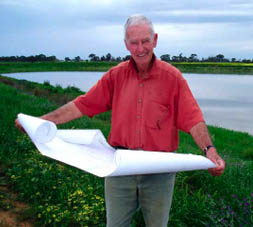 |
 |
|
Environmental stewardship
In seeking autonomy and self determination, irrigators have also taken on responsibility for the environmental management of the region. In the late 1980s irrigators put forward proposals for a major expansion of surface drainage networks to address both water logging and rising water tables. But before it would commit funding, the NSW Government wanted a regional strategy which considered a range of different actions. Over the next five years the Murray Land and Water Management Plans (LWMPs) were developed, with extensive input from local landholders. They are a 30 year, natural resource management program that aims to achieve a sustainable irrigation landscape. Murray Irrigation is responsible for implementing the plans, and this began in 1995. The plan area actually extends beyond the companyís operations, to include private irrigation schemes along the NSW-Victorian border ~ a total area of 950,000 hectares and 3,075 farms. The LWMP program has 15 years of Federal, State and Local Government funding, ending in 2010. Landholders contribute through levies on their water as well as cash and in-kind contributions to works on their properties. Government investment to 2007 totals $68 million; and landholder contributions amount to $347 million. LWMP initiatives include:
|
Farm plans
Blighty landholder Don Henderson, above, is one of the many farmers in the region who has developed a farm plan to improve the layout and water efficiency of his property. Farm storages like Mr Hendersonís capture rainfall run-off and irrigation tail water which can be re-used for irrigation. |
|
| sitemap • credits
& references • copyright • local
history links • contact & contribute • VISITORS |
||

